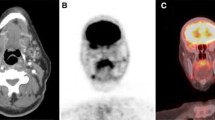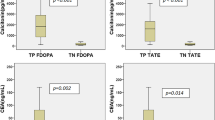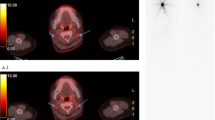Abstract
Purpose
This was a retrospective study to detect and map the extent of disease in recurrent medullary thyroid carcinoma (MTC) using the novel PET somatostatin analogue 68Ga-DOTATATE and conventional 18F-FDG positron emission tomography/computed tomography (PET/CT).
Methods
Eighteen patients (13 men, 5 women, median age: 54 years) who had previously been operated on for MTC and presented with biochemical (raised calcitonin levels) and/or imaging evidence of recurrence underwent both 68Ga-DOTATATE and 18F-FDG PET/CT within a maximum interval of 4 weeks (median interval of 1 week). 68Ga-DOTATATE- and 18F-FDG-avid lesions were recorded per patient as well as per region in six distinct regions: (1) thyroid bed—local recurrence, (2) cervical lymph nodes, (3) mediastinum, (4) lungs, (5) liver and (6) bones. The 68Ga-DOTATATE and 18F-FDG PET/CT findings were classified as positive or negative on visual interpretation. These findings were further characterised as concordant or discordant, depending on whether there was agreement or discrepancy in imaging with the two radiotracers. A separate analysis of the unenhanced CT component of the examination was performed. Verification of the lesions was achieved by histopathological analysis, further imaging studies and clinical follow-up.
Results
68Ga-DOTATATE PET/CT imaging achieved disease detection in 13 of 18 and 18F-FDG PET/CT in 14 of 18 patients. These results corresponded to per-patient sensitivities of 72.2% [95% confidence interval (CI): 46.4–89.3%] for 68Ga-DOTATATE versus 77.8% (95% CI: 51.9–92.6%) for 18F-FDG (non-significant difference). 18F-FDG revealed a total of 28 metastatic MTC regions and 68Ga-DOTATATE 23 regions. In ten patients a discordant tracer pattern of per-region and/or per-lesion distribution of recurrent disease was observed, while in four patients a concordant pattern was noted (no lesions were detected by either modality in the remaining four patients).
Conclusion
Neither 18F-FDG nor 68Ga-DOTATATE PET/CT can fully map the extent of disease in patients with recurrent MTC, although 18F-FDG PET/CT may identify more lesions. However, 68Ga-DOTATATE PET/CT can be a useful complementary imaging tool and may identify patients suitable for consideration of targeted radionuclide somatostatin analogue therapy.



Similar content being viewed by others
References
Ball DW. Medullary thyroid cancer: monitoring and therapy. Endocrinol Metab Clin North Am 2007;36:823–37. viii.
Scollo C, Baudin E, Travagli JP, Caillou B, Bellon N, Leboulleux S, et al. Rationale for central and bilateral lymph node dissection in sporadic and hereditary medullary thyroid cancer. J Clin Endocrinol Metab 2003;88:2070–5.
Moley JF, DeBenedetti MK. Patterns of nodal metastases in palpable medullary thyroid carcinoma: recommendations for extent of node dissection. Ann Surg 1999;229:880–7. discussion 887–8.
Rufini V, Treglia G, Perotti G, Leccisotti L, Calcagni ML, Rubello D. Role of PET in medullary thyroid carcinoma. Minerva Endocrinol 2008;33:67–73.
Elisei R, Bottici V, Luchetti F, Di Coscio G, Romei C, Grasso L, et al. Impact of routine measurement of serum calcitonin on the diagnosis and outcome of medullary thyroid cancer: experience in 10,864 patients with nodular thyroid disorders. J Clin Endocrinol Metab 2004;89:163–8.
Rufini V, Castaldi P, Treglia G, Perotti G, Gross MD, Al-Nahhas A, et al. Nuclear medicine procedures in the diagnosis and therapy of medullary thyroid carcinoma. Biomed Pharmacother 2008;62:139–46.
Kebebew E, Ituarte PH, Siperstein AE, Duh QY, Clark OH. Medullary thyroid carcinoma: clinical characteristics, treatment, prognostic factors, and a comparison of staging systems. Cancer 2000;88:1139–48.
Jiménez C, Hu MI, Gagel RF. Management of medullary thyroid carcinoma. Endocrinol Metab Clin North Am 2008;37:481–96. x-xi.
de Groot JW, Links TP, Jager PL, Kahraman T, Plukker JT. Impact of 18F-fluoro-2-deoxy-D-glucose positron emission tomography (FDG-PET) in patients with biochemical evidence of recurrent or residual medullary thyroid cancer. Ann Surg Oncol 2004;11:786–94.
Koopmans KP, de Groot JW, Plukker JT, de Vries EG, Kema IP, Sluiter WJ, et al. 18F-dihydroxyphenylalanine PET in patients with biochemical evidence of medullary thyroid cancer: relation to tumor differentiation. J Nucl Med 2008;49:524–31.
von Schulthess GK, Steinert HC, Hany TF. Integrated PET/CT: current applications and future directions. Radiology 2006;238:405–22.
Ong SC, Schöder H, Patel SG, Tabangay-Lim IM, Doddamane I, Gönen M, et al. Diagnostic accuracy of 18F-FDG PET in restaging patients with medullary thyroid carcinoma and elevated calcitonin levels. J Nucl Med 2007;48:501–7.
Zatelli MC, Piccin D, Tagliati F, Bottoni A, Luchin A, Vignali C, et al. Selective activation of somatostatin receptor subtypes differentially modulates secretion and viability in human medullary thyroid carcinoma primary cultures: potential clinical perspectives. J Clin Endocrinol Metab 2006;91:2218–24.
Mato E, Matias-Guiu X, Chico A, Webb SM, Cabezas R, Berná L, et al. Somatostatin and somatostatin receptor subtype gene expression in medullary thyroid carcinoma. J Clin Endocrinol Metab 1998;83:2417–20.
Papotti M, Kumar U, Volante M, Pecchioni C, Patel YC. Immunohistochemical detection of somatostatin receptor types 1–5 in medullary carcinoma of the thyroid. Clin Endocrinol 2001;54:641–9.
Reubi JC, Schar JC, Waser B, Wenger S, Heppeler A, Schmitt JS, et al. Affinity profiles for human somatostatin receptor subtypes SST1-SST5 of somatostatin radiotracers selected for scintigraphic and radiotherapeutic use. Eur J Nucl Med 2000;27:273–82.
Kayani I, Bomanji JB, Groves A, Conway G, Gacinovic S, Win T, et al. Functional imaging of neuroendocrine tumors with combined PET/CT using 68Ga-DOTATATE (DOTA-DPhe1, Tyr3-octreotate) and 18F-FDG. Cancer 2008;112:2447–55.
Rufini V, Calcagni ML, Baum RP. Imaging of neuroendocrine tumors. Semin Nucl Med 2006;36:228–47.
Costante G, Durante C, Francis Z, Schlumberger M, Filetti S. Determination of calcitonin levels in C-cell disease: clinical interest and potential pitfalls. Nat Clin Pract Endocrinol Metab 2009;5:35–44.
Behr TM, Becker W. Metabolic and receptor imaging of metastatic medullary thyroid cancer: does anti-CEA and somatostatin-receptor scintigraphy allow for prognostic predictions? Eur J Nucl Med 1999;26:70–1.
Giraudet AL, Vanel D, Leboulleux S, Auperin A, Dromain C, Chami L, et al. Imaging medullary thyroid carcinoma with persistent elevated calcitonin levels. J Clin Endocrinol Metab 2007;92:4185–90.
Diehl M, Risse JH, Brandt-Mainz K, Dietlein M, Bohuslavizki KH, Matheja P, et al. Fluorine-18 fluorodeoxyglucose positron emission tomography in medullary thyroid cancer: results of a multicentre study. Eur J Nucl Med 2001;28:1671–6.
Szakall S Jr, Esik O, Bajzik G, Repa I, Dabasi G, Sinkovics I, et al. 18F-FDG PET detection of lymph node metastases in medullary thyroid carcinoma. J Nucl Med 2002;43:66–71.
Iagaru A, Masamed R, Singer PA, Conti PS. Detection of occult medullary thyroid cancer recurrence with 2-deoxy-2-[F-18]fluoro-D-glucose-PET and PET/CT. Mol Imaging Biol 2007;9:72–7.
Musholt TJ, Musholt PB, Dehdashti F, Moley JF. Evaluation of fluorodeoxyglucose-positron emission tomographic scanning and its association with glucose transporter expression in medullary thyroid carcinoma and pheochromocytoma: a clinical and molecular study. Surgery 1997;122:1049–60. discussion 1060–1.
Van Essen M, Krenning EP, De Jong M, Valkema R, Kwekkeboom DJ. Peptide receptor radionuclide therapy with radiolabelled somatostatin analogues in patients with somatostatin receptor positive tumours. Acta Oncol 2007;46:723–34.
Bodei L, Handkiewicz-Junak D, Grana C, Mazzetta C, Rocca P, Bartolomei M, et al. Receptor radionuclide therapy with 90Y-DOTATOC in patients with medullary thyroid carcinomas. Cancer Biother Radiopharm 2004;19:65–71.
Waldherr C, Schumacher T, Pless M, Crazzolara A, Maecke HR, Nitzsche EU, et al. Radiopeptide transmitted internal irradiation of non-iodophil thyroid cancer and conventionally untreatable medullary thyroid cancer using [90Y]-DOTA-D-Phe1-Tyr3-octrotide: a pilot study. Nucl Med Commun 2001;22:673–8.
Conflicts of interest
None.
Author information
Authors and Affiliations
Corresponding author
Additional information
An Editorial Commentary on this paper is available at http://dx.doi.org/10.1007/s00259-009-1247-1
Rights and permissions
About this article
Cite this article
Conry, B.G., Papathanasiou, N.D., Prakash, V. et al. Comparison of 68Ga-DOTATATE and 18F-fluorodeoxyglucose PET/CT in the detection of recurrent medullary thyroid carcinoma. Eur J Nucl Med Mol Imaging 37, 49–57 (2010). https://doi.org/10.1007/s00259-009-1204-z
Received:
Accepted:
Published:
Issue Date:
DOI: https://doi.org/10.1007/s00259-009-1204-z




